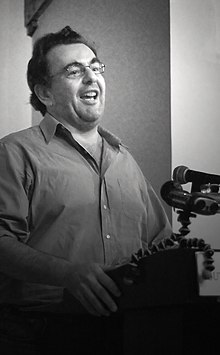fiction.wikisort.org - Writer
Paul Di Filippo (born October 29, 1954) is an American science fiction writer.[2] He is a regular reviewer for print magazines Asimov's Science Fiction, The Magazine of Fantasy and Science Fiction, Science Fiction Eye, The New York Review of Science Fiction, Interzone, and Nova Express, as well as online at Science Fiction Weekly. He is a member of the Turkey City Writer's Workshop. Along with Michael Bishop, Di Filippo has published a series of novels under the pseudonym Philip Lawson.
This biography of a living person needs additional citations for verification. (January 2010) |
Paul Di Filippo | |
|---|---|
 | |
| Born | October 29, 1954 Woonsocket, Rhode Island[1] |
| Occupation | Writer |
| Nationality | American |
| Genre | Science fiction |
| Website | |
| paul-di-filippo | |
Antonio Urias writes that Di Filippo's writing has a "tradition of the bizarre and the weird".[3]
His novella A Year in the Linear City was nominated for a Hugo award.
Early life
Di Filippo was born in Woonsocket, Rhode Island.
Critical reception
Antonio Urias praised the collection The Steampunk Trilogy (1995) in a brisk review, writing in summary that the tripartite book "contains three bizarre and occasionally humorous novels taking the reader from Queen Victoria's amphibian doppelganger to racist naturalists and black magic, and finally the interdimensional love story of Emily Dickinson and Walt Whitman."
The first novella, simply entitled "Victoria" follows Cosmo Cowperhwait the inventor of a human-amphibian hybrid that bares an uncanny resemblance to Her Majesty, Queen Victoria, as well as an insatiable sexual appetite. This is a satire of Victorian mores, politics, and, of course, of the stereotypical mad scientist.
...The second novella is Hottentots is (sic) less outrageously funny, at least on the surface. This is in part due to the fact that the story is told, for the most part through the eyes of Swiss-born naturalist Louis Agassiz, who is apart from pompous and self-aggrandizing, also a proud unrepentant racist. As a result, Di Filippo adopts a more satirical tone as Agassiz confronts anarchists, voodoo, academic maneuverings, swordfights, and a Lovecraftian horror all without losing a hint of his arrogance or smug assurances.
The final novella, Walt and Emily, follows Emily Dickinson and Walt Whitman's blossoming love as they join a spiritualist and scientific expedition into the afterlife. More than either of the previous stories, "Walt and Emily" delights in literary references and games. The story is saturated with poetic quotations and the unrepentant silly fun not only of a love story between Dickenson and Whitman but the idea of them visiting the afterlife.[3]
Bibliography
References
- Silver, Steven (2014-09-10). "An Interview with Paul di Filippo, Early Steampunk Adopter". Amazing Stories. Retrieved 2014-09-10.
- "Paul Di Filippo, 1954–". Contemporary Authors. Autobiography Series. Vol. V. 29. 1998. pp. 79–99.
- Urias, Antonio (July 11, 2014). "Book Review: The Steampunk Trilogy by Paul Di Filippo". Antonio Urias. Retrieved January 31, 2015.
External links
- Official website

- Paul Di Filippo: author's page at 40kBooks.com
- Weird Universe created by Di Filippo, Alex Boese & Chuck Shepherd
- Paul Di Filippo at the Internet Speculative Fiction Database
- Paul Di Filippo at The Encyclopedia of Science Fiction
- Paul Di Filippo's online fiction at Free Speculative Fiction Online
- Golden Gryphon Press site for Strange Trades
- 2006 interview with Paul Di Filippo at small WORLD podcast
На других языках
- [en] Paul Di Filippo
[ru] Ди Филиппо, Пол
Пол Ди Филиппо (англ. Paul Di Filippo; р. 29 октября 1954) — американский писатель-фантаст и журналист, сотрудник «Вашингтон пост» и ряда других изданий, выступает со статьями на различные темы: от литературной критики до музыкальных обзоров.Другой контент может иметь иную лицензию. Перед использованием материалов сайта WikiSort.org внимательно изучите правила лицензирования конкретных элементов наполнения сайта.
WikiSort.org - проект по пересортировке и дополнению контента Википедии